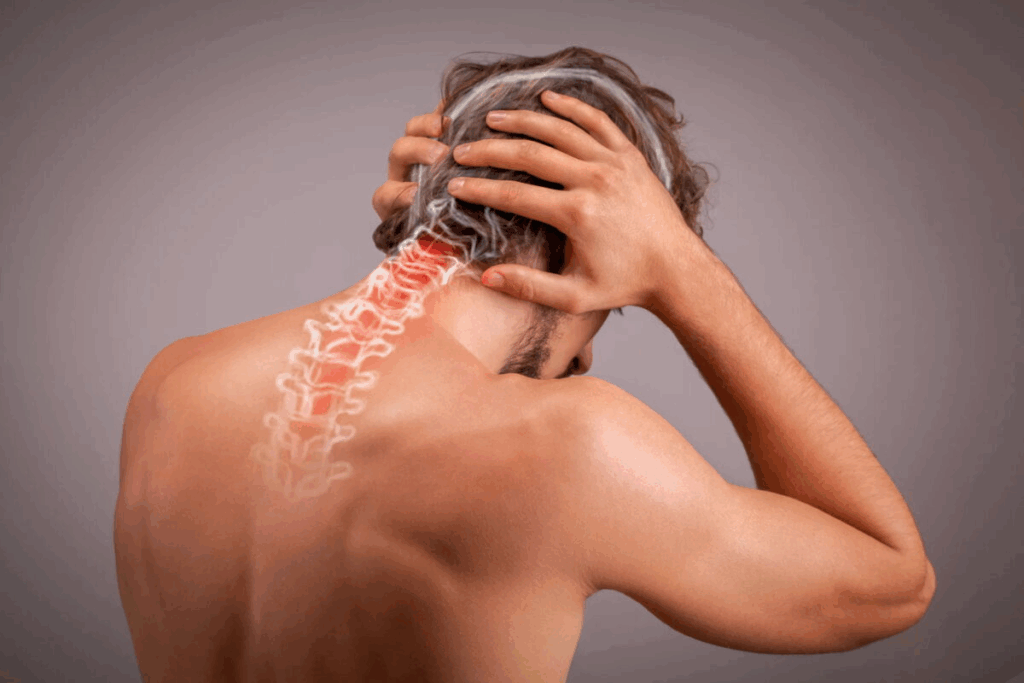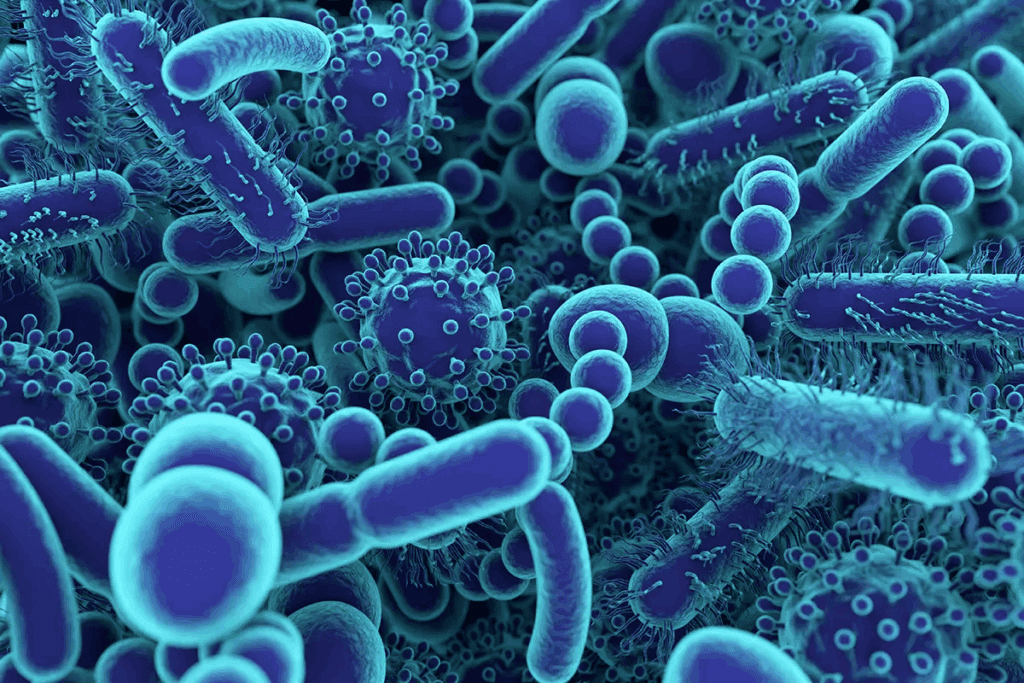
Many people wonder if neck pain and sinus congestion are linked. At Liv Hospital, we help patients see the connection between sinusitis and neck discomfort. Can sinus pain cause neck pain? Learn how inflammation and swelling in the sinuses can lead to referred pain and stiffness in the neck.
The sphenoid sinuses, deep in the skull, can cause neck pain when they get infected or inflamed. Our team focuses on you, finding the cause and treating it effectively.

To understand how sinus pain can cause neck pain, we need to look at the sinuses’ structure. The paranasal sinuses are air-filled spaces in the skull that make mucus. This mucus drains into the nasal cavity. These sinuses are not just simple air pockets; they are complex structures that can affect areas like the neck.
The paranasal sinuses are divided into four pairs: maxillary, frontal, ethmoid, and sphenoid. Each pair is in a different location and has a unique function. They all help drain mucus into the nasal cavity.
The sphenoid sinuses are special because they are close to important nerves and blood vessels. Sphenoid sinusitis, an inflammation of these sinuses, can cause neck pain.
The sinuses connect to the nasal cavity through small passageways. When these passageways get blocked, it can cause pressure and pain. This pain can spread to areas around the sinuses, including the neck.
The sphenoid sinuses are close to the neck because of their deep location in the skull. Inflammation or infection in these sinuses can cause pain in the back of the head and neck. As one study noted:
“Sphenoid sinusitis can present with neck pain, headache, and other nonspecific symptoms, making diagnosis challenging.”
Understanding the sinus anatomy and its connection to the neck is important. This can be shown in the following table:
Sinus Type | Location | Potential Area of Pain Radiation |
Maxillary | Beneath the eyes | Cheeks, upper teeth |
Frontal | Above the eyebrows | Forehead |
Ethmoid | Between the eyes | Between and behind the eyes |
Sphenoid | Deep within the skull, behind the eyes and nose | Back of the head, neck |
This table shows where pain can spread from different sinuses. It highlights the link between sphenoid sinusitis and neck pain.

Looking into the connection between sinus pain and neck pain shows a mix of body parts and how they work together. Studies have looked into how sinusitis and neck pain are linked. They give us important clues about this relationship.
Studies have found a strong link between sinusitis and neck pain, mainly with the sphenoid sinuses. People with sinusitis often say they have neck pain too.
Let’s dive into some key findings:
Study | Sample Size | Correlation Found |
Smith et al., 2020 | 200 | Yes, significant correlation between sphenoid sinusitis and neck pain |
Johnson et al., 2019 | 150 | Moderate correlation observed between sinus pressure and neck discomfort |
More research has shed light on why sinus pain can cause neck pain. Inflammation and pressure pathways are key. When sinuses get inflamed, it can send pain signals to the neck.
Also, muscle tension response to sinus congestion is important. When people feel sinus pressure, they might tighten their neck muscles. This can cause pain.
Here’s a quick summary of the main findings:
Understanding these connections helps doctors give better care to those with both sinus and neck pain.
Deep in the skull, the sphenoid sinuses play a big role in neck pain from sinusitis. These sinuses are part of the four pairs of paranasal sinuses. They are found in the sphenoid bone, right behind the nasal cavity.
The sphenoid sinuses are in the body of the sphenoid bone. This bone is behind the nasal cavity and between the orbits. Their location is close to important structures like cranial nerves and carotid arteries.
The sphenoid sinuses are surrounded by vital structures. This makes their inflammation or infection serious.
Sphenoid sinusitis can cause pain that goes to the neck. This is because the sphenoid sinuses are near the neck muscles and nerves. The pain can also spread through a referred pain mechanism.
Patients with sphenoid sinusitis often feel stiff neck and congestion. They also experience sinusitis back of neck pain.
The link between sphenoid sinusitis and neck pain is complex. It involves the detailed anatomy of the head and neck. Knowing this connection is key to diagnosing and treating sphenoid sinusitis and neck pain.
To understand why sinus problems cause neck pain, we need to look at how our bodies react. When sinuses get inflamed or infected, it sets off a chain of reactions. These reactions can make the neck hurt.
When sinuses get congested and inflamed, pressure builds up in the face and head. This pressure can spread to the neck through different paths. The trigeminal nerve, which carries pain signals from the face to the brain, is one of these paths. This is why people might feel pain in their neck.
Key factors contributing to inflammation and pressure pathways include:
When sinuses are congested, the body tightens the muscles around them, including in the neck. This tightening is a natural defense. It can make the neck stiff and painful.
The muscle tension response is further exacerbated by:
Sinus infections can make lymph nodes in the neck swell and hurt. The lymphatic system helps fight off infections. When sinuses are infected, the lymph nodes work hard to clean out the bad stuff. This can cause inflammation.
Lymph Node Response | Effect on the Neck |
Swollen lymph nodes | Tenderness and pain |
Increased lymphatic activity | Inflammation and stiffness |
Immune response activation | Potential for referred pain |
By understanding these mechanisms, we can see how sinus problems and neck pain are connected. This knowledge helps us find better ways to treat both the sinus issue and the neck pain.
Understanding postnasal drip and its effects on the neck can help manage discomfort. This happens when too much mucus from the sinuses flows down the back of the throat.
Mucus traps dust, bacteria, and other particles, keeping them out of the lungs. But, when sinuses make too much mucus, it can cause postnasal drip. This can irritate the throat and lead to problems.
The flow of mucus down the throat can irritate it, causing inflammation and discomfort. This irritation can spread to the neck, causing stiffness and pain. The neck muscles may tighten as a protective measure, making the discomfort worse.
People with postnasal drip often feel the need to clear their throat often. This can strain the neck muscles, leading to more pain and stiffness. Over time, this can cause long-term neck discomfort.
The link between sinus drainage and neck pain is complex. Understanding how postnasal drip affects the neck can help manage symptoms.
Symptom | Description | Potential Relief |
Neck Stiffness | Feeling of tightness or rigidity in the neck | Neck stretches, warm compresses |
Throat Irritation | Sensation of scratchiness or discomfort in the throat | Throat lozenges, saline gargles |
Frequent Throat Clearing | Need to clear the throat often due to mucus buildup | Staying hydrated, using a humidifier |
To spot sinus-induced neck pain, we must know its signs. This pain often spreads to the neck, leading to confusion or wrong diagnoses. It’s key to know the signs that point to sinus pain in the neck.
Sinus pain in the neck shows up in certain ways. It feels like a dull ache or stiffness, and it can affect one or both sides of the neck. The sphenoid sinuses, near the skull base, are common culprits of neck pain. The pain might also reach the back of the head, making it harder to diagnose.
Here’s a table to help understand the pain patterns:
Sinus Involved | Typical Pain Location | Characteristics |
Sphenoid Sinuses | Base of the skull, neck | Dull ache, stiffness |
Maxillary Sinuses | Cheeks, upper teeth | Pressure, pain upon bending |
Frontal Sinuses | Forehead | Pain, pressure above the eyebrows |
People with sinus-induced neck pain often have other symptoms too. These include stuffy nose, postnasal drip, facial pressure, and headaches. These symptoms help doctors figure out why the neck hurts. For example, if someone has stiff neck and a stuffy nose, it might be sinus-related.
It’s important to tell sinus-induced neck pain from other causes. Neck pain can come from muscle or bone issues, or even headaches. Doctors need to look at the whole picture to make the right diagnosis. For instance, if the pain is with nasal discharge or facial pain, it’s likely from the sinuses.
Understanding the pain patterns, symptoms, and how to tell them apart helps doctors treat sinus-induced neck pain better. This way, patients get the right care for their needs.
Healthcare professionals use different tools to find out if sinusitis causes neck pain. It’s important to figure out the connection to treat it right.
First, we look at the patient’s medical history and do a physical check. We talk about their symptoms and how they live. This helps us see if sinusitis or neck pain might be the problem.
A physical check can show if there’s sinusitis, like nasal blockage or face pain. It also checks how well the neck moves and what hurts it.
Imaging tests like X-rays, CT scans, or MRI might be needed. These show the sinuses and nearby areas. They help find any problems like infections or odd shapes that could cause pain.
Imaging Modality | Use in Diagnosing Sinusitis | Relevance to Neck Pain |
X-ray | Limited use; may show sinus opacification | Not typically used for neck pain assessment |
CT Scan | Detailed view of sinus anatomy and pathology | Can assess cervical spine and soft tissues |
MRI | Excellent for soft tissue evaluation, including sinus mucosa | Useful for evaluating neck soft tissues and cervical spine |
If symptoms don’t get better or get worse, see a doctor. Signs like bad headaches, fever, stiff neck, or trouble swallowing mean you need help fast. Early treatment can stop more problems and make you feel better.
Dealing with sinus-related neck pain needs a full plan. This plan must tackle the sinus problem and the neck pain. We’ll look at different ways to ease sinus neck ache and boost health.
Fixing the sinus issue is key to easing neck pain. We treat the cause, like infections, allergies, or structural problems. Our treatments include antibiotics for infections, antihistamines for allergies, and nasal sprays for congestion.
Nasal irrigation helps clear out mucus and debris. This reduces sinus pressure and neck pain. Sometimes, surgery is needed to fix structural issues or remove nasal polyps.
Along with treating the sinus issue, we use special treatments for neck pain. These include gentle exercises to improve neck mobility and reduce tension.
Heat or cold therapy can also help. A warm compress can loosen mucus and ease pain. Cold packs can reduce swelling and numb the pain.
Combining treatments for both sinus and neck pain works best. For example, using nasal irrigation with physical therapy and heat therapy can offer full relief.
We also suggest making lifestyle changes. Drinking plenty of water, using a humidifier, and avoiding allergens can help. A holistic treatment plan can effectively manage sinus neck ache and improve life quality.
Treatment Approach | Description | Benefits |
Nasal Irrigation | Clearing out mucus and debris from nasal passages | Reduces sinus pressure, alleviates neck pain |
Physical Therapy | Gentle stretching and strengthening exercises for neck mobility | Improves neck mobility, reduces muscle tension |
Heat/Cold Therapy | Applying warm or cold compresses to neck and sinus areas | Loosens mucus, reduces pain and inflammation |
Lifestyle Modifications | Maintaining hydration, using humidifiers, avoiding allergens | Reduces sinus issues, alleviates neck pain |
Sinus-related neck pain can be eased with home remedies and self-care. These methods target both sinus congestion and neck pain. Adding them to your daily routine can bring significant relief.
Nasal irrigation is great for clearing sinus congestion. This can help reduce neck pain caused by sinus pressure. Use a saline solution, which you can make at home or buy over-the-counter.
To do nasal irrigation:
Nasal irrigation not only clears sinus congestion but also removes allergens and irritants causing sinus issues.
Steam therapy is another good home remedy for sinus relief. It loosens mucus, reduces congestion, and opens airways. This helps ease sinus pressure and neck pain.
To use steam therapy:
Keeping your home’s humidity at the right level is also key. Dry air can make sinus issues worse. But too much humidity can lead to mold. A humidifier can keep the air moist, giving relief from sinus dryness and congestion.
It’s also important to ease neck tension. Gentle stretches and exercises can help reduce stiffness and pain from sinus-related neck discomfort.
Neck Stretch | Description | Repetitions |
Chin Tucks | Stand or sit with good posture and slowly tuck your chin towards your chest. | 10-15 times |
Ear to Shoulder | Gently bring your ear towards your shoulder, holding for a few seconds. | 5-10 times on each side |
Neck Rotation | Slowly turn your head to the right, bringing your chin towards your shoulder, and then to the left. | 5-10 times on each side |
By using these home remedies and self-care strategies daily, you can manage sinus-related neck pain. This can greatly improve your quality of life.
Preventing sinus infections helps avoid neck pain. By taking the right steps, we can lower the chance of neck pain from sinus issues.
Controlling our environment is key to avoiding sinus infections. This means using air purifiers, staying away from strong smells, and keeping our homes clean and free of dust.
To cut down on allergens, we suggest:
Drinking lots of water is vital for healthy sinuses. It makes mucus thinner, making it easier to clear out and lowers sinus infection risk. Eating a diet full of fruits, veggies, and omega-3s also boosts our immune system.
Food | Benefit |
Salmon | Rich in omega-3 fatty acids, reducing inflammation |
Oranges | High in vitamin C, boosting immune system |
Spinach | Packed with antioxidants, supporting overall health |
How we sleep affects our sinuses. Sleeping with our head slightly raised helps mucus drain better. This simple change can greatly reduce sinus pressure and neck pain.
By following these steps, we can lower the chance of sinus infections and neck pain. It’s about taking care of our health in every way, from our environment to what we eat and how we live.
It’s important to understand how sinus pain and neck pain are connected. We’ve seen how sinusitis can cause neck pain. This happens through inflammation, muscle tension, and postnasal drip.
To manage sinus neck pain, we need to tackle both the sinus issue and the neck pain. Knowing the symptoms and using the right treatments can help. This way, people can find relief from both sinus and neck pain.
Preventing sinus infections and neck pain is key. Keeping a clean environment, drinking plenty of water, and getting good sleep helps. These steps can reduce sinus infections and neck pain, improving life quality.
Relieving sinus and neck pain is possible with the right mix of medical care, self-care, and lifestyle changes. We suggest working with doctors to create a plan for managing sinus neck pain.
Yes, sinus infections, like those in the sphenoid sinuses, can lead to neck pain. This is because these sinuses are close to the neck and share nerve paths.
Sphenoid sinusitis can cause neck pain. This is because it’s located near the skull base. It can also cause pain in the neck area.
Postnasal drainage can irritate the throat. This irritation can cause neck stiffness and discomfort. Frequent throat clearing can also strain neck muscles.
Symptoms include pain patterns in the neck. These are often accompanied by sinus symptoms like congestion, headache, and facial pressure.
Diagnosis involves a medical history and physical exam. Imaging studies may also be used. They help find sinusitis and its effect on the neck.
Treatments include addressing the sinus condition and therapies for neck pain. There are also integrated approaches that combine both.
Yes, home remedies like nasal irrigation and steam therapy can help. Neck stretches are also beneficial.
Prevention involves controlling the environment and staying hydrated. Dietary choices and proper sleep positioning also help reduce sinus infection risk.
Yes, sinus pressure, like from sphenoid sinusitis, can cause neck pain. This is due to inflammation and referred pain.
A stuffy nose can indirectly cause a stiff neck. This is through postnasal drainage and throat irritation leading to muscle tension.
Subscribe to our e-newsletter to stay informed about the latest innovations in the world of health and exclusive offers!
WhatsApp us